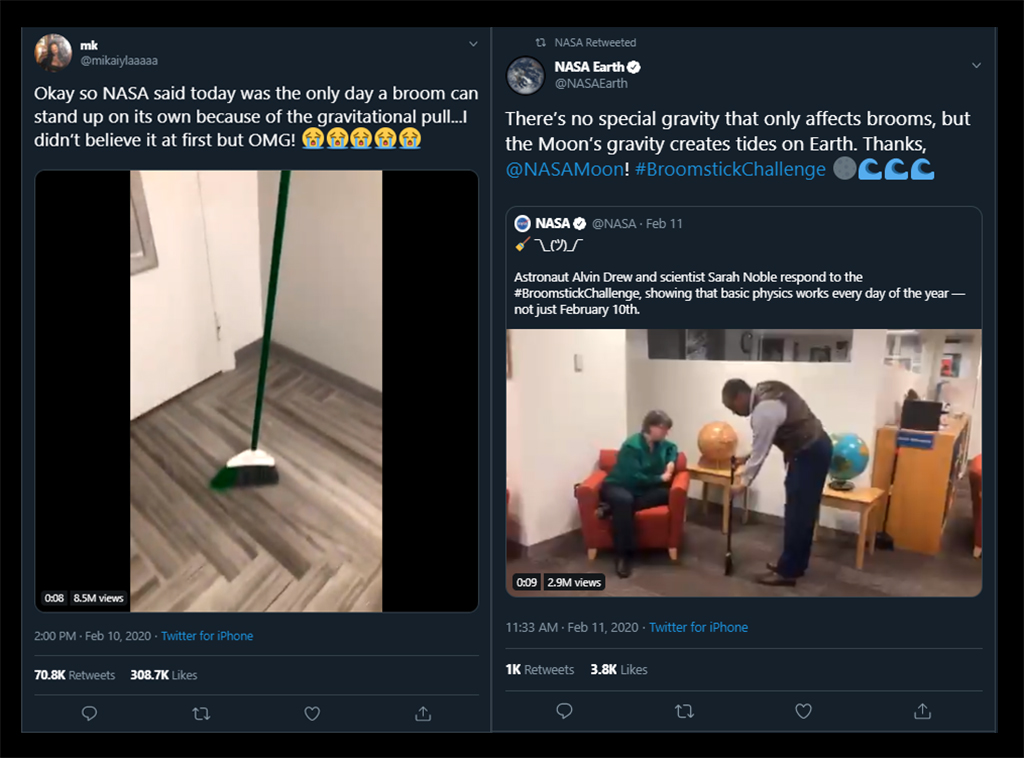
UHCL students processing misinformation is not just fake news
As a student at the University of Houston–Clear Lake (UHCL), there are several on-campus resources to cultivate the ability to process information and recognize misinformation.
Merriam-Webster defines “misinformation” as incorrect or misleading information. Fake news, hoaxes, disinformation and deliberate false news are some of the many aspects and results of misinformation. Misinformation is most easily spread when the information presented has an element of truth woven into the falsities or references a reputable source.
An example of spreading misinformation was on Feb. 10 when a tweet attributed NASA saying the Earth’s gravitational pull on that day allowed brooms to stand on their own. NASA’s Twitter account quickly debunked the story with a video on Feb. 11 illustrating ‘basic physics,’ not the earth’s gravitational pull, is what allows brooms to stand on their own.

Not all misinformation is so quickly or effectively debunked. Often readers are left to decipher which is true and which is misinformation. On-campus resources that students can use to process facts from fiction include the First Year Seminar, library resources, and Quality Enhancement Plans (QEP).
The First-Year Seminar Program includes PSYC 1100 Learning Frameworks and the Common Reader Program.
“The entire class, the Learning Frameworks class, is about how do we understand the information that we are surrounded by, and how do we intervene in that information in order to make good logical arguments,” said Anne Gessler, clinical assistant professor in the First-Year Seminar Program who also teaches in the History and Women and Gender Studies Programs.
Gessler uses the idea of critical thinking in her Learning Frameworks courses to challenge and test information that the students encounter. Gessler said one way that students can engage in critical thinking skills outside of the classroom is through the Common Reader Program. Each year the program chooses a novel with social significance.
The novel for the 2019-2020 academic year is “Spare Parts” by Joshua Davis. It is the true story of four undocumented teenagers in a national robotics competition. The program uses the book as a platform for relevant and engaging discussions and plans events based on intersecting concepts.
Another resource that is used by the class, and can be used by all students, are librarian consultations. A librarian can provide guidance to help navigate information literacy and provide resources to promote critical thinking.
The UHCL website has a section on the Neumann Library webpage dedicated to critical thinking skills. There are resources and videos available to all who have access. The CRAAP Test, which tests the credibility of sources for academic use, is one of the tools professors use in conjunction with the library.
“It’s got a bad name in libraries, to be honest, but I think a lot of faculty still really appreciate it,” said Travis Jones, research and instruction librarian. “It’s basically currency, relevant, accuracy, authority and purpose [CRAAP]. That was for a long time the paradigm through which we would have students think about information.”
Professors, in turn, have access to information on critical thinking through Quality Enhancement Plans (QEP). Robert Bartsch, program director for the Center for Faculty Development and professor of psychology, states that UHCL chose critical thinking as the first topic because it helped classify different types of critical thinking and ways to evaluate critical thinking. The information provided through the critical thinking QEP is then available to be implemented into the curriculum, which allows critical thinking skills to be developed within any given degree plan.
“The Miniature Guide to Critical Thinking” by the Foundation for Critical Thinking is what faculty and staff use in PYSC 1100 Learning Frameworks for implementing critical thinking. The Foundation for Critical Thinking states on its website that “critical thinking is the art of analyzing information and evaluating thinking with a view to improving it.”
Newsfeeds that show up on social media outlets are common ways for information to be received and distributed and, therefore, allows for ample opportunity for the information to be wrong or inaccurate.
“Don’t wait for your news to passively come to you,” said Wanalee Romero, clinical assistant professor and director of the First-Year Seminar Program. “Because any way that news is going to passively come to you, there is already a way that it’s being deteriorated.”
